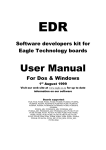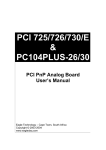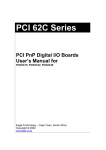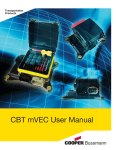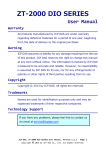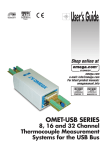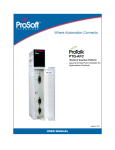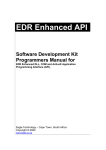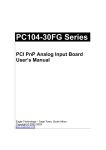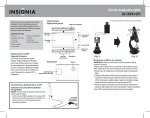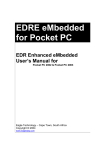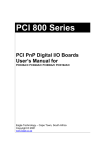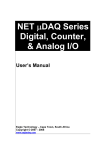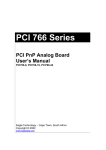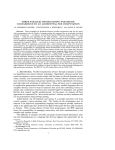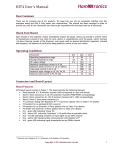Download PCI 14 Series
Transcript
PCI 14 Series PCI PnP Digital I/O Board User’s Manual Revision 1.3 Eagle Technology – Cape Town, South Africa Copyright © 2001 PCI 14 Series User Manual Eagle Technology - Data Acquisition Digital I/O Boards Data Acquisition and Process Control © Eagle Technology 31-35 Hout Street • Cape Town • South Africa Eagle Technology © Copyright 2001 i PCI 14 Series User Manual Eagle Technology - Data Acquisition Copyright All rights reserved. No part of this publication may be reproduced, stored in a retrieval system, or transmitted, in any form or any means, electronic, mechanical, by photographing, recording, or otherwise without prior written permission. Copyright © Eagle Technology, South Africa August 2001 Revision 1.3 Information furnished in this manual is believed to be accurate and reliable; however no responsibility is assumed for its use, or any infringements of patents or other rights of third parties, which may result from its use. Trademarks and Logos in this manual are the property of their respective owners. Product Warranty Eagle Technology, South Africa, warrants its products from defect in material and workmanship from confirmed date of purchase for a period of one year if the conditions listed below are met. The product warranty will call the Eagle Technology Data Acquisition Device short as ETDAQD. • • • The warranty does not apply to an ETDAQD that has been previously repaired, altered, extended by any other company or individual outside the premises of Eagle Technology. That a qualified person configure and install the ETDAQD, and damages caused to a device during installation shall make the warranty void and null. The warranty will not apply to conditions where the ETDAQD has been operated in a manner exceeding its specifications. Eagle Technology, South Africa, does not take responsibility or liability of consequential damages, project delays, damaging of equipment or capital loss as a result of its products. Eagle Technology, South Africa, holds the option and final decision to repair or replace any ETDAQD. Proof of purchase must be supplied when requesting a repair. Eagle Technology © Copyright 2001 ii PCI 14 Series User Manual Eagle Technology - Data Acquisition TABLE OF CONTENTS 1. INTRODUCTION 1 Features 1 Applications 2 Key Specifications 2 Software Support 2 Contact Details 2 2. 3 INSTALLATION Package 3 Hardware Installation 3 Software Installation Windows 98/2000/ME Post installation Windows NT Testing your board 4 4 7 8 9 Accessories 9 3. INTERCONNECTIONS 10 External Connectors 10 Pin Assignments 10 Signal Definitions 11 Digital Inputs 11 Digital Outputs 11 Counters 12 4. 13 FUNCTIONAL OVERVIEW Device Address Map 13 Counter Mode Register [2..0] 14 Counter Count Register [23..0] 14 Eagle Technology © Copyright 2001 iii PCI 14 Series User Manual Eagle Technology - Data Acquisition Counter Configuration Register [2..0] 14 Interrupt Mask Register [13..0] 14 Interrupt Control Register [27..0] 15 Interrupt Status Register [13..0] 15 Counter Mode 0 – Interrupt on terminal count. 15 Counter Mode 1 – Hardware re-triggerable one shot. 16 Counter Mode 2 – Rate Generator. 16 Counter Mode 3 – Square Wave Generator. 17 Counter Mode 4 – Software Triggered Strobe. 17 Counter Mode 5 – Hardware Triggered Strobe 18 Minimum Initial Counter Limits 18 5. 19 PROGRAMMING GUIDE EDR Enhanced API 19 Examples 19 Digital Inputs Reading the Digital Inputs 19 20 Digital Outputs Writing to the Digital Outputs 20 20 Counters Writing the initial counter value Reading a Counter Configuring a counter Controlling the counter gate Configuration Constants 20 20 21 21 21 22 Multi Function I/O Configuring the outputs 22 22 Programming Interrupts Configuring the Interrupt sub-system Enabling Interrupts Disabling Interrupts Programming interrupts by using the EDREIntX OCX Visual Basic Interrupt Example 23 23 24 24 25 25 A. 26 I/O ELECTRICAL SPECIFICATIONS Eagle Technology © Copyright 2001 iv PCI 14 Series User Manual B. Eagle Technology - Data Acquisition CONFIGURATION CONSTANTS 27 Query Codes 27 Error Codes 28 Digital I/O Codes 28 C. 29 ORDERING INFORMATION Eagle Technology © Copyright 2001 v PCI 14 Series User Manual Eagle Technology - Data Acquisition Table of Figures Figure 2-1 Add New Hardware Wizard Step1 ................................................. 4 Figure 2-2 Add New Hardware Wizard Step2 ................................................. 5 Figure 2-3 Add New Hardware Wizard Step3 ................................................. 5 Figure 2-4 Add New Hardware Wizard Step4 ................................................. 6 Figure 2-5 Add New Hardware Wizard Step5 ................................................. 6 Figure 2-6 Restart Your Computer .................................................................. 7 Figure 2-7 System Properties.......................................................................... 7 Figure 2-8 EagleDAQ ...................................................................................... 8 Figure 4-1 Counter Mode 0 ........................................................................... 16 Figure 4-2 Counter Mode 1 ........................................................................... 16 Figure 4-3 Counter Mode 2 ........................................................................... 17 Figure 4-4 Counter Mode 3 ........................................................................... 17 Figure 4-5 Counter Mode 4 ........................................................................... 17 Figure 4-6 Counter Mode 5 ........................................................................... 18 Eagle Technology © Copyright 2001 vi PCI 14 Series User Manual Eagle Technology - Data Acquisition Table of Tables Table 1-1 PCI14 Versions ............................................................................... 1 Table 3-1 External Connector – SCSI 68F CENT ......................................... 11 Table 3-2 Input ports ..................................................................................... 11 Table 3-3 Output ports .................................................................................. 11 Table 4-1 Device Address Map ..................................................................... 13 Table 4-2 Counter Mode Register ................................................................. 14 Table 4-3 Counter Configuration Register..................................................... 14 Table 4-4 Interrupt Mask Register ................................................................. 15 Table 4-5 Interrupt Control Register .............................................................. 15 Table 4-6 Mode and initial count limits .......................................................... 18 Table 5-1 Clock Configuration....................................................................... 22 Table 5-2 Gate Configuration ........................................................................ 22 Table 5-3 Multiple I/O Configuration.............................................................. 23 Table 5-4 EDRE_IntConfigure Parameters ................................................... 24 Table A-1 I/O Electrical Specifications .......................................................... 26 Table B-1 Query Code .................................................................................. 27 Table B-2 Error Codes .................................................................................. 28 Table B-3 Digital I/O Codes........................................................................... 28 Table C-1 Ordering Information..................................................................... 29 Eagle Technology © Copyright 2001 vii PCI 14 Series User Manual Eagle Technology - Data Acquisition 1 1. Introduction The PCI14 series are 32-bit PCI bus architecture data acquisition boards. They are available in two basic models, the B and C. The PCI14 contains digital input and output ports and onboard counters. The PCI14 is a multipurpose digital board that can be used in many applications. It also contains features for digital input and output protection. The counter modes are compatible with the Intel 8254. Features The PCI14 does have some very unique features and are short listed below: • • • • • • • • • • 32-bit PCI bus Revision 2.2 compliant at 33MHz. PCI Bus 3.3V compatible. 6 counters for B version and 2 for C version. Counter modes are compatible with Intel 8254. Fully configurable counter sub-system; includes internal clock source (40MHz) or external, internal or external gates. 24 x digital input lines and 24 x digital output lines. 50 mA sink, 20 mA source digital outputs with short circuit protection. High impedance on power up or loss. Overvoltage protection on all digital inputs. Overvoltage protection on digital outputs (B version only). Fully programmable interrupt system: interrupts generated from counters or 8 x digital inputs. Feature Number of digital input channels Number of digital output channels Number of 24-bit counters High voltage digital input protection High voltage digital output protection PCI14B 24 24 6 Yes Yes PCI14C 24 24 2 Yes No Table 1-1 PCI14 Versions Eagle Technology © Copyright 2001 1 PCI 14 Series User Manual Eagle Technology - Data Acquisition Applications The PCI14 can be used in the following applications: • Digital control applications. • Digital monitoring applications. • Frequency measurement. • Pulse generation. • Timing applications. • Pulse counting. Key Specifications • • • 24-bit digital input port. 24-bit digital output port. 24-bit counters. Software Support The PCI14 is supported by EDR Enhanced and comes with an extensive range of examples. The software will help you to get your hardware going very quickly. It also makes it easy to develop complicated control applications quickly. All operating system drivers, utility and test software are supplied on the EDR Enhanced CD-Rom. The latest drivers can also be downloaded from the Eagle Technology website. For further support information see the Contact Details section. Contact Details Eagle Technology © Copyright 2001 2 PCI 14 Series User Manual Eagle Technology - Data Acquisition 2 2. Installation This chapter describes how to install and configure the PCI14 for the first time. Minimal configuration is necessary; almost all settings are done through software. The PCI BIOS or operating system will take care of all resource assignments. Package PCI14 package will contain the following: • PCI14 PCI board • EDR Enhanced Software Development Kit CD-Rom Hardware Installation This section will describe how to install your PCI14 into your computer. • Switch off the computer and disconnect from power socket. Failure to disconnect all power cables can result in hazardous conditions, as there may be dangerous voltage levels present in externally connected cables. • • • • • • Remove the cover of the PC. Choose any open PCI slot and insert PCI14 board Insert bracket screw and ensure that the board sits firmly in the PCI socket. Replace the cover of the PC. Reconnect all power cables and switch the power on. The hardware installation is now completed. Eagle Technology © Copyright 2001 3 PCI 14 Series User Manual Eagle Technology - Data Acquisition Software Installation Windows 98/2000/ME Installing the Windows 98/2000 device driver is a very straightforward task. Because it is plug and play Windows will auto detect the PCI14 as soon as it is installed. No setup is necessary. You simply have to supply Windows with a device driver. Wait until Windows detects the new hardware Figure 2-1 Add New Hardware Wizard Step1 Select Next Eagle Technology © Copyright 2001 4 PCI 14 Series User Manual Eagle Technology - Data Acquisition Figure 2-2 Add New Hardware Wizard Step2 Select default option, search for best driver and select next Figure 2-3 Add New Hardware Wizard Step3 Select specify a location and enter the directory location of the driver on the Eagle CD Rom. The driver should be located in the <CDROM>:\EDRE\Drivers\WDM\PCI14B directory. Select Next to proceed Eagle Technology © Copyright 2001 5 PCI 14 Series User Manual Eagle Technology - Data Acquisition Figure 2-4 Add New Hardware Wizard Step4 Windows should have detected the proper driver and ready to install it. Select Next to proceed. Figure 2-5 Add New Hardware Wizard Step5 Click on the finish button to complete the installation. Click Yes to restart your computer. Eagle Technology © Copyright 2001 6 PCI 14 Series User Manual Eagle Technology - Data Acquisition Figure 2-6 Restart Your Computer Post installation After your installation was complete there is a few steps that can be followed to check that your installation was successful. • • First make sure that the driver is working properly by opening the system folder in the control panel. Check under the Eagle Data Acquisition list if your board is listed and working properly. See picture below. Figure 2-7 System Properties • Clearly you can see that the PCI14 is listed and working properly. Eagle Technology © Copyright 2001 7 PCI 14 Series User Manual • Eagle Technology - Data Acquisition Further open the control panel and then the EagleDAQ folder. This dialog should list all installed hardware. Verify your board’s properties on this dialog. See picture below Figure 2-8 EagleDAQ Now the first part of your installation has been completed and ready to install the EDR Enhanced Software Development Kit. • Run setup.exe found on the EDR Enhanced SDK CD-Rom and follow the on screen instructions Windows NT Windows NT does not require any special setup procedure. The Windows NT driver does not support plug and play. If Windows 2000 detects a new device simply install a default driver, or so called placeholder. To install the Windows NT drivers simply run EDREWinnt.exe on the Eagle CD-Rom. This will automatically install the device drivers. Restart your computer when done. Open the EagleDAQ folder in the control panel to check if your installation was successful. Figure 2-8 shows a successful installation. Eagle Technology © Copyright 2001 8 PCI 14 Series User Manual Eagle Technology - Data Acquisition Testing your board To test your board, run the application supplied on the Eagle CD-Rom. Install the following program <EAGLECD>:\EDRE\APPS\PCI14B\pci14b.exe. Run it to test all features on your board. Accessories The PCI14 does have a wide variety of accessories that it can be connected too. See the Eagle Technology catalog for more information. Eagle Technology © Copyright 2001 9 PCI 14 Series User Manual Eagle Technology - Data Acquisition 3 3. Interconnections The PCI14 has got one external connector that includes both digital I/O and counter signals. All connections are made through this connector situated on the card’s bracket. External Connectors The PCI14 has a SCSI female centronics 68-way connector. As part of the accessories a cable and adapter can be ordered. Pin Assignments The table below shows the pin assignments for the PCI14. Pin 1 2 3 4 5 6 7 8 9 10 11 12 13 14 15 16 17 18 19 20 21 22 Name +5V DI2 DI4 DI6 DI8 DI10 DI12 Di14 DI16 DI18 DI20 DI22 DI24 DGND CNTR0_CLK CNTR1_CLK CNTR2_CLK CNTR3_CLK CNTR4_CLK CNTR5_CLK DGND DO1/CNTR0_TC Pin 35 36 37 38 39 40 41 42 43 44 45 46 47 48 49 50 51 52 53 54 55 56 Name +5V DI1 DI3 DI5 DI7 DI9 DI11 DI13 DI15 DI17 DI19 DI21 DI23 DGND CNTR0_GATE CNTR1_GATE CNTR2_GATE CNTR3_GATE CNTR4_GATE CNTR5_GATE DGND DO2/CNTR1_TC Eagle Technology © Copyright 2001 10 PCI 14 Series User Manual 23 24 25 26 27 28 29 30 31 32 33 34 DO3/CNTR2_TC DO5/CNTR4_TC DO7 DO9 DO11 DO13 DO15 DO17 DO19 DO21 DO23 DGND 57 58 59 60 61 62 63 64 65 66 67 68 Eagle Technology - Data Acquisition DO4/CNTR3_TC DO6/CNTR5_TC DO8 DO10 DO12 DO14 DO16 DO18 DO20 DO22 DO24 DGND Table 3-1 External Connector – SCSI 68F CENT Signal Definitions This sections deal with all the signals abbreviations. Signal DI1-24 DO1-24 CNTRx_CLK CNTRx_GATE +5V DGND Description Digital Inputs Digital outputs External clock lines External gate lines +5V power supply line Digital ground Table 3-2 Signal definitions Digital Inputs The PCI14 has got 24 digital input lines. See specification for input protection. Please note when programming the PCI14 the 24 lines are split into 3 ports of 8-bits. This is to be compatible with the ISA PC14B. Port 0 1 2 Lines 1-8 9-16 17-24 Table 3-2 Input ports Digital Outputs The PCI14 has got 24 digital output lines. See specification for output protection. Please note when programming the PCI14 the 24 lines are split into 3 port of 8-bits. This is to be compatible with the ISA PC14B. The outputs can also be configured to be high impedance. Lines 1-6 are the same as the 6 terminal count lines of the counters and must be configured for either. Port 0 1 2 Lines 1-8 9-16 17-24 Table 3-3 Output ports Eagle Technology © Copyright 2001 11 PCI 14 Series User Manual Eagle Technology - Data Acquisition Counters There are 6 counter or 2 counters on the PCI14 depending on the version. The counter modes are fully compatible with the Intel 8254 and can be programmed for internal clock or gate or external clock or gate or a combination of clock and gates. All external clock and gate lines are accessed via the external connector. The terminal count lines are shared with the first 6 digital output lines and have to be configured for either. It has an internal clock of 40MHz. Eagle Technology © Copyright 2001 12 PCI 14 Series User Manual Eagle Technology - Data Acquisition 4 4. Functional Overview This section provides a functional overview of the PCI14B board. Device Address Map The table below defines the address map as per offset of base address 0. Offset Address (HEX) 000 004 008 010 014 018 020 024 028 030 034 038 040 044 048 050 054 058 080 084 088 08C 090 0A0 0B0 Register Name Description CNT0_MODE CNT0_COUNT CNT0_CONFIG CNT1_MODE CNT1_COUNT CNT1_CONFIG CNT2_MODE CNT2_COUNT CNT2_CONFIG CNT3_MODE CNT3_COUNT CNT3_CONFIG CNT4_MODE CNT4_COUNT CNT4_CONFIG CNT5_MODE CNT5_COUNT CNT5_CONFIG INT_MASK INT_CONTROL INT_STATUS OUTPUT_CNTRL OUTPUT_REG INPUT_REG EEPROM_REG Mode Register Initial count / Current count Configuration Mode Register Initial count / Current count Configuration Mode Register Initial count / Current count Configuration Mode Register Initial count / Current count Configuration Mode Register Initial count / Current count Configuration Mode Register Initial count / Current count Configuration Interrupt mask Interrupt control Interrupt status / Reset Setup output sources Setting output lines Reading input lines EEPROM Interface Read/Write W W/R W W W/R W W W/R W W W/R W W W/R W W W/R W W W W/R W W R W/R Table 4-1 Device Address Map Eagle Technology © Copyright 2001 13 PCI 14 Series User Manual Eagle Technology - Data Acquisition Counter Mode Register [2..0] This is a 3-bit register defining the mode of a specific counter. If written to the Terminal Count(TC) will be initialized. Bits[0..2] [2 | 1 | 0] [0 : 0 : 0] [0 : 0 : 1] [0 : 1 : 0] [0 : 1 : 1] [1 : 0 : 0] [1 : 0 : 1] Description Mode 0 Mode 1 Mode 2 Mode 3 Mode 4 Mode 5 Table 4-2 Counter Mode Register Counter Count Register [23..0] By writing to the count register the initial count of the counter is determined. The value will be loaded and when clocked the counter will start to count down. By reading the count register the current count value is returned. This register is 24-bits wide. Counter Configuration Register [2..0] The counter configuration register is used to setup the source clock and gate for each counter. Writing to this register always forces the Terminal Count (TC) line to initialize. Bit[0..2] Bit 0 Bit [2:1] Description Specifies the Clock Source 0 : Clock source is internal – 40 MHz 1 : Clock source is external 00 : Gate is disabled 01 : Gate is enabled 10 : Gate is external Table 4-3 Counter Configuration Register Interrupt Mask Register [13..0] The interrupt mask register is used to enable or disable all 14 interrupt sources. Eight interrupt are derived from the first 8 digital input lines and 6 from the counters. A logic 1 mask an interrupt and a logic 0 enables an interrupt. Bits [0..13] Bit 0 Bit 1 Bit 2 Bit 3 Bit 4 Bit 5 Description Input line 0 Input line 1 Input line 2 Input line 3 Input line 4 Input line 5 Eagle Technology © Copyright 2001 14 PCI 14 Series User Manual Bit 6 Bit 7 Bit 8 Bit 9 Bit 10 Bit 11 Bit 12 Bit 13 Eagle Technology - Data Acquisition Input line 6 Input line 7 Counter terminal count 0 Counter terminal count 1 Counter terminal count 2 Counter terminal count 3 Counter terminal count 4 Counter terminal count 5 Table 4-4 Interrupt Mask Register Interrupt Control Register [27..0] The interrupt control register is used to setup each interrupt source. Each source can be programmed for edge/level or polarity trigger. Bits [0..27] Bit [1:0] Bit [3:2] Bit [5:4] Bit [7:6] Bit [9:8] Bit [11:10] Bit [13:12] Bit [15:14] Bit [17:16] Bit [19:18] Bit [21:20] Bit [23:22] Bit [25:24] Bit [27:26] Description Input 0: 0 : 0 Rising Edge 0 : 1 Falling Edge 1 : 0 Level ‘1’ 0 : 0 Level ‘0’ Input 1 Input 2 Input 3 Input 4 Input 5 Input 6 Input 7 Counter 0 TC Counter 1 TC Counter 2 TC Counter 3 TC Counter 4 TC Counter 5 TC Table 4-5 Interrupt Control Register Interrupt Status Register [13..0] The Interrupt Status Register supply information on current triggered interrupts. The register is 14-bit wide for each interrupt source. If set Counter Mode 0 – Interrupt on terminal count. Eagle Technology © Copyright 2001 15 PCI 14 Series User Manual Eagle Technology - Data Acquisition Figure 4-1 Counter Mode 0 TC will be initialized to ‘0’ two clocks after the counter is loaded with an initial count. TC will toggle to a ‘1’ one clock after the counter has reached zero. This state is maintained until the initial count is re-loaded. Gate =’1’ enabled counting. Gate = ‘0’ disable counting. Only the rising edge of Gate is significant. Counter Mode 1 – Hardware re-triggerable one shot. Figure 4-2 Counter Mode 1 The rising edge of GATE reloads the counter with the initial count, initializes TC to ‘1’ and starts the down-count sequence. Further rising edges of GATE will re-initialize this state. TC will toggle to ‘0’ whenever the counter reaches the count of two. This state is maintained until a new GATE trigger event is detected. Counter Mode 2 – Rate Generator. Eagle Technology © Copyright 2001 16 PCI 14 Series User Manual Eagle Technology - Data Acquisition Figure 4-3 Counter Mode 2 TC will be initialized to ‘1’ two clocks after the counter is loaded with an initial count and the counter enabled to count down (GATE =’1’). On the clock following the count of ONE, the counter will be reloaded with the initial count and TC toggled to a ‘0’. TC will toggle back to a ‘1’ on the next clock. This sequence is maintained. Gate = ‘1’ enables counting. Gate = ‘0’ disable counting. Counter Mode 3 – Square Wave Generator. Figure 4-4 Counter Mode 3 This is the similar to mode 2 except that TC has a 50% duty cycle signal. Counter Mode 4 – Software Triggered Strobe. Figure 4-5 Counter Mode 4 Eagle Technology © Copyright 2001 17 PCI 14 Series User Manual Eagle Technology - Data Acquisition TC and the counter are initialized whenever the software writes the initial count register. TC will pulse low for one clock period after the counter has reached zero. Note that is sequence is re-triggerable if the initial count is written before the terminal count condition is reached. Gate = ‘1’ enables counting. Gate = ‘0’ disables counting. Counter Mode 5 – Hardware Triggered Strobe Figure 4-6 Counter Mode 5 Similar to mode four with the exception that the rising edge of GATE is used to re-trigger the initial counter and TC conditions. Minimum Initial Counter Limits The minimum initial counter values are mode dependent and defined as in the Table below. Mode 0 1 2 3 4 5 Minimum initial count value 1 1 2 2 1 1 Table 4-6 Mode and initial count limits Eagle Technology © Copyright 2001 18 PCI 14 Series User Manual Eagle Technology - Data Acquisition 5 5. Programming Guide The PCI14B/C is supplied with a complete software development kit. EDR Enhanced (EDRE SDK) comes with drivers for many operating systems and a common application program interface (API). The API also serves as a hardware abstraction layer (HAL) between the control application and the hardware. The EDRE API makes it possible to write an application that can be used on all hardware with common sub-systems. The PCI14B/C can also be programmed at register level, but it is not recommended. A detailed knowledge of the PCI14B/C is needed and some knowledge about programming Plug and Play PCI devices. We recommend that you only make use of the software provided by Eagle Technology. EDR Enhanced API The EDR Enhanced SDK comes with both ActiveX controls and a Windows DLL API. Examples are provided in many different languages and serve as tutorials. EDRE is also supplied with a software manual and user’s guide. The EDRE API hides the complexity of the hardware and makes it really easy to program the PCI14. It has got functions for each basic sub-system and is real easy to learn. Examples Please refer to the examples directory found in the EDRE folder of the CDRom. There are some complete PCI14B examples. Digital Inputs Digital inputs are used to read or monitor devices with a digital output capability. The PCI14B/C has got 24 inputs and depending on which version extensive or minimal input protection. The 24 inputs lines are split into 3 x 8bit ports and assigned in the following configuration; lines 0-7 represents port 0, lines 8-15 represents port 1, lines 16-23 represents port 2. Eagle Technology © Copyright 2001 19 PCI 14 Series User Manual Eagle Technology - Data Acquisition Reading the Digital Inputs A single call is necessary to read a digital I/O port. API-CALL Long EDRE_DioRead(ulng Sn, ulng Port, ulng *Value) The serial number, port, and a pointer to variable to hold the result must be passed by the calling function. A return code will indicate if any errors occurred. ACTIVEX CALL Long EDREDioX.Read(long Port) Only the port-number needs to be passed and the returned value will either hold an error or the value read. If the value is negative an error did occur. Digital Outputs Digital outputs are used to control devices with digital inputs. The PCI14B/C has got 24 inputs and depending on which version extensive or minimal output protection. The 24 inputs lines are split into 3 x 8-bit ports and assigned in the following configuration; lines 0-7 represents port 0, lines 8-15 represents port 1, lines 16-23 represents port 2. Writing to the Digital Outputs A single call is necessary to write to a digital I/O port. API-CALL Long EDRE_DioWrite(ulng Sn, ulng Port, ulng Value) The serial number, port, and a value must be passed by the calling function. A return code will indicate if any errors occurred. ACTIVEX CALL Long EDREDioX.Write(long Port, ulng Value) The port number and value to be written needs to be passed and the returned value holds an error or the value read. If the value is negative an error did occur. Counters The counter sub-system is supported by functions to Read, Write, Configure and controlling the gate. Writing the initial counter value A single call is necessary to write a counter’s initial load value. API-CALL Long EDRE_CTWrite(ulng Sn, ulng Ct, ulng Value) The serial number, counter-number, and a value must be passed by the calling function. A return code will indicate if any errors occurred. Eagle Technology © Copyright 2001 20 PCI 14 Series User Manual Eagle Technology - Data Acquisition ACTIVEX CALL Long EDRECTX.Write(long Port, ulng Value) The port number and value to be written needs to be passed and the returned value holds an error or the value read. If the value is negative an error did occur. Reading a Counter A single call is necessary to read a counter’s current value. API-CALL Long EDRE_CTRead(ulng Sn, ulng Ct, ulng *Value) The serial number, counter-number, and a pointer to variable to hold the result must be passed by the calling function. A return code will indicate if any errors occurred. ACTIVEX CALL Long EDRECTX.Read(long Ct) Only the counter-number needs to be passed and the returned value will either hold an error or the value read. If the value is negative an error did occur. The counter-number and value to be written needs to be passed and the returned value holds an error or the value read. If the value is negative an error did occur. Configuring a counter A single call is necessary to configure a counter. API-CALL Long EDRE_CTConfig(ulng Sn, ulng Ct, ulng Mode, ulng Type, ulng ClkSrc, ulng GateSrc) The serial number, counter-number, mode, type (this parameter is ignored), clock source and gate source is needed to specify a counter’s configuration. A return code will indicate if any errors occurred. ACTIVEX CALL Long EDRECTX.Configure(long ct, long mode, long type, ulng source, ulng gate) The counter-number, mode, type (this parameter is ignored), clock source and gate source is needed to specify a counter’s configuration. A return code will indicate if any errors occurred. Controlling the counter gate A single call is necessary to setup/control a counter’s gate API-CALL Long EDRE_CTSoftGate(ulng Sn, ulng Ct, ulng Gate) The serial number, counter-number and gate is needed to control a counter’s gate. A return code will indicate if any errors occurred. Eagle Technology © Copyright 2001 21 PCI 14 Series User Manual Eagle Technology - Data Acquisition ACTIVEX CALL Long EDRECTX.SoftGate(ulng Ct, ulng Gate) The counter-number and mode is needed to control a counter’s gate. A return code will indicate if any errors occurred. Configuration Constants These values are acceptable as a clock source. Value 0 1 Description Internal 40Mhz External Table 5-1 Clock Configuration These values are acceptable as a gate source. Value 0 1 2 Description Gate disabled Gate enabled Gate external Table 5-2 Gate Configuration Multi Function I/O The PCI14 has got some multi I/O lines. These are I/O lines on the connector that is shared by the counter and digital outputs. The output lines can also be configured to be high impedance or enabled. The multi I/O configure function is used to set this up. Configuring the outputs A single call is necessary to configure the output lines of the PCI14. API-CALL Long EDRE_MioConfig(ulng Sn, ulng Port, ulng Value) The serial number, Port/Line number, and a value must be passed by the calling function. A return code will indicate if any errors occurred. ACTIVEX CALL Long EDREDioX.MioConfigure(long Port, long Value) The port-number and value to be written needs to be passed and the returned value holds an error or the value read. If the value is negative an error did occur. Please use the table below as reference. Port 0 1 2 Value 0 : Output 0 1 : Counter 0 TC 0 : Output 1 1 : Counter 1 TC 0 : Output 2 Eagle Technology © Copyright 2001 22 PCI 14 Series User Manual 3 4 5 6 Eagle Technology - Data Acquisition 1 : Counter 2 TC 0 : Output 3 1 : Counter 3 TC 0 : Output 4 1 : Counter 4 TC 0 : Output 5 1 : Counter 6 TC 0 : Outputs are high impedance 1 : Outputs are active Table 5-3 Multiple I/O Configuration Programming Interrupts The PCI14B can generate interrupts from 14 different sources, which include digital inputs and counters. The interrupt sub-system is totally programmable and user-space interrupt-service-routines are triggered through events from the driver. If an event is triggered it also needs to be cleared. The EDRE interrupt system includes functions to configure, enable, disable. The configuration function is used to configure a specific interrupt source and Enable and Disable to globally control interrupts. WARNING! Be careful when programming the interrupt sub-system because it is easy to generate interrupts that is faster than what Windows can service. Don’t try and generate interrupt faster than 10KHz. This will not work. Remember this is 10KHz in total, and not per source. The PCI14B interrupt service routine will stop servicing interrupts if at any stage it is still busy with an interrupt and the next one is generated. Configuring the Interrupt sub-system A single call is necessary to configure the interrupt sub-system. API-CALL Long EDRE_IntConfigure(ulng Sn, ulng Src, ulng Mode, ulng Type) Parameter Sn Src Type Unsigned long Unsigned long Description Board’s Serial Number Interrupt Source No Description 0 DIO Line 0 1 DIO Line 1 2 DIO Line 2 3 DIO Line 3 4 DIO Line 4 5 DIO Line 5 6 DIO Line 6 7 DIO Line 7 8 TC Counter 0 9 TC Counter 1 10 TC Counter 2 Eagle Technology © Copyright 2001 23 PCI 14 Series User Manual Eagle Technology - Data Acquisition 10 11 12 13 Mode Unsigned long Type Unsigned long RETURN Long TC Counter 2 TC Counter 3 TC Counter 4 TC Counter 5 Disable or Enable a source 0 : Disable 1 : Enable Set the type of trigger for the interrupt No Description 0 Rising Edge 1 Falling Edge 2 Level = ‘1’ 3 Level = ‘0’ This parameter contains the error code return. If =0 then no error occurred. Table 5-4 EDRE_IntConfigure Parameters ACTIVEX CALL Long EDREIntX.Configure(long Source, long Mode, long Type) As the DLL call the ActiveX function takes the same parameters except the serial number. Enabling Interrupts A single call is necessary to enable the interrupt sub-system. This will also enable the global interrupt on the PCI14B and connect it to the PCI Bus. API-CALL Long EDRE_IntEnable(ulng Sn) Only a serial number needs to be specified. The return code will contain the status of the call. ACTIVEX-CALL Long EDREIntX.Enable A returned error code will contain the status of the call. Disabling Interrupts A single call is necessary to disable the interrupt sub-system. API-CALL Long EDRE_IntDisable(ulng Sn) Only a serial number needs to be specified. The return code will contain the status of the call. ACTIVEX-CALL Long EDREIntX.Disable A returned error code will contain the status of the call. Eagle Technology © Copyright 2001 24 PCI 14 Series User Manual Eagle Technology - Data Acquisition Programming interrupts by using the EDREIntX OCX The interrupt OCX makes programming interrupts very easy. You only have to configure the interrupts, Enable/Disable it and implement a trigger. The trigger will also supply you with the source of the interrupt. By simply clicking on the control your programming language will jump to the code for you trigger procedure. Visual Basic Interrupt Example Option Explicit Dim err As Long Private Sub Command1_Click() EDREIntX1.Enable End Sub Private Sub Command2_Click() EDREIntX1.Disable End Sub Private Sub EDREIntX1_Interrupt(ByVal Source As Long) 'this is the interrupt service routine End Sub Private Sub Form_Load() sn = EDREUtlX1.SelectDialog() 'get a board's serial number EDREIntX1.SerialNumber = sn 'set the interrupt OCX serial number err = EDREIntX1.Configure(0, 1, 0) 'configure interrupt system 'source = 0, mode = enable, type = 0 End Sub Eagle Technology © Copyright 2001 25 PCI 14 Series User Manual Eagle Technology - Data Acquisition A A. I/O Electrical Specifications SPECIFICATION Digital Inputs Minimum input voltage (Relative to DGND) to register a logic ‘1’ Maximum input voltage (Relative to DGND) to register a logic ‘0’ Maximum Input Frequency Maximum Continuous Input Voltage (Relative to DGND) Maximum Input Voltage Spike < 100 ms (Relative to DGND) Counter Clock and Gate Control Inputs Minimum input voltage (Relative to DGND) to register a logic ‘1’ Maximum input voltage (Relative to DGND) to register a logic ‘0’ Maximum Input Frequency Maximum Continuous Input Voltage (Relative to DGND) Maximum Input Voltage Spike < 50 ms (Relative to DGND) Digital Outputs & Counter Timer Outputs Number of Digital Outputs (Multiplexed with counter TC outputs.) Sink current (Output voltage =< 0.5V) Source current (Output voltage >= 2.5V) Maximum Output Frequency Short Circuit protection Maximum Continuous Over Voltage Stress (Note 1) Maximum Continuous Under Voltage Stress (Note 1) Maximum Output Voltage Spike < 50 ms (Relative to DGND) PCI-14B PCI-14C + 2.5 V + 1.0 V 8 MHz ± 32 V ± 80 V + 2.5 V + 1.0 V 8 MHz ± 32 V ± 80 V + 2.5 V + 1.0 V 8 MHz ± 32 V ± 80 V + 2.5V + 1.0 V 8 MHz ± 32 V ± 80 V 24 - 48 mA + 18 mA 8 MHz - 40 to – 140 mA + 32 V - 32 V ± 80 V 24 - 48 mA + 18 mA 8 MHz -40 to –140 mA + 5.5 V - 0.8 V - Table A-1 I/O Electrical Specifications Note 1. For Option B, the outputs are protected by 100 mA ± 20 mA (at 25°C) polyfuses and 5.6V transorbs. Over or under voltage stress levels longer than 50 ms will activate the fuse protecting the driver. Note also that once activated such fuses have a fairly long recovery time. Eagle Technology © Copyright 2001 26 PCI 14 Series User Manual Eagle Technology - Data Acquisition B B. Configuration Constants Query Codes Name APIMAJOR APIMINOR APIBUILD APIOS APINUMDEV BRDTYPE BRDREV BRDYEAR BRDMONTH BRDDAY BRDSERIALNO DRVMAJOR DRVMINOR DRVBUILD ADNUMCHAN ADNUMSH ADMAXFREQ ADBUSY ADFIFOSIZE ADFIFOOVER ADBUFFSIZE ADBUFFOVER ADBUFFALLOC ADUNREAD ADEXTCLK ADEXTTRIG ADBURST ADRANGE DANUMCHAN DAMAXFREQ DABUSY DAFIFOSZ CTNUM CTBUSY DIONUMPORT DIOQRYPORT DIOPORTWIDTH INTNUMSRC INTSTATUS INTBUSCONNECT INTISAVAILABLE INTNUMTRIG Value 1 2 3 4 5 10 11 12 13 14 15 20 21 22 100 101 102 103 104 105 106 107 108 109 110 111 112 113 200 201 202 203 300 301 400 401 402 500 501 502 503 504 Description Query EDRE API major version number. Query EDRE API minor version number. Query EDRE API build version number. Query EDRE API OS type. Query number of devices installed. Query a board’s type. Query a board’s revision. Query a board’s manufactured year. Query a board’s manufactured month. Query a board’s manufactured day. Query a board’s serial number. Query a driver’s major version number. Query a driver’s minor version number. Query a driver’s build version number. Query number of ADC channel. Query number of samples-and-hold channels. Query maximum sampling frequency. Check if ADC system is busy. Get ADC hardware FIFO size. Check for FIFO overrun condition. Check software buffer size. Check for circular buffer overrun. Check if software buffer is allocated. Get number of samples available. Get status of external clock line – PCI30FG. Get status of external trigger line – PCI30FG. Check if burst mode is enabled. Get ADC range. Query number of DAC channels. Query maximum DAC output frequency. Check if DAC system is busy. Get DAC FIFO size. Query number of counter-timer channels. Check if counter-timer system is busy. Query number of digital I/O ports. Query a specific port for capabilities. Get a specific port’s width. Query number of interrupts sources. Queries interrupt system’s status. Connect interrupt system to bus. Check if an interrupt is available. Check number times interrupted Table B-1 Query Code Eagle Technology © Copyright 2001 27 PCI 14 Series User Manual Eagle Technology - Data Acquisition Error Codes Name EDRE_OK EDRE_FAIL EDRE_BAD_FN EDRE_BAD_SN EDRE_BAD_DEVICE EDRE_BAD_OS EDRE_EVENT_FAILED EDRE_EVENT_TIMEOUT EDRE_INT_SET EDRE_DA_BAD_RANGE EDRE_AD_BAD_CHANLIST EDRE_BAD_FREQUECY EDRE_BAD_BUFFER_SIZE EDRE_BAD_PORT EDRE_BAD_PARAMETER EDRE_BUSY EDRE_IO_FAIL EDRE_BAD_ADGAIN EDRE_BAD_QUERY EDRE_BAD_CHAN EDRE_BAD_VALUE EDRE_BAD_CT EDRE_BAD_CHANLIST EDRE_BAD_CONFIG EDRE_BAD_MODE EDRE_HW_ERROR EDRE_HW_BUSY EDRE_BAD_BUFFER EDRE_REG_ERROR EDRE_OUT_RES EDRE_IO_PENDING Value 0 -1 -2 -3 -4 -5 -6 -7 -8 -9 -10 -11 -12 -13 -14 -15 -16 -17 -18 -19 -20 -21 -22 -23 -24 -25 -26 -27 -28 -29 -30 Description Function successfully. Function call failed. Invalid function call. Invalid serial number. Invalid device. Function not supported by operating system. Wait on event failed. Event timed out. Interrupt in use. DAC value out of range. Channel list size out of range. Frequency out of range. Data passed by buffer incorrectly sized Port value out of range. Invalid parameter value specified. System busy. IO call failed. ADC-gain out of range. Query value not supported. Channel number out of range. Configuration value specified out of range. Counter-timer channel out of range. Channel list invalid. Configuration invalid. Mode not valid. Hardware error occurred. Hardware busy. Buffer invalid. Registry error occurred. Out of resources. Waiting on I/O completion Value 0 1 2 3 Description Port is an output. Port is an input. Port can be configured as in or out. Port is an input and an output. Table B-2 Error Codes Digital I/O Codes Name DIOOUT DIOIN DIOINOROUT DIOINANDOUT Table B-3 Digital I/O Codes Eagle Technology © Copyright 2001 28 PCI 14 Series User Manual Eagle Technology - Data Acquisition C C. Ordering Information . Board PCI 14B PCI 14C Description 48 channel digital I/O and 6 counters board. 48 channel digital I/O and 2 counters board. Table C-1 Ordering Information Eagle Technology © Copyright 2001 29







































